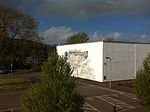Aylesford Priory

Aylesford Priory, or "The Friars" was founded in 1242 when members of the Carmelite order arrived in England from Mount Carmel in the Holy Land. Richard de Grey, a crusader, sponsored them, and conveyed to the order a parcel of land located on his manor in Aylesford in Kent. The estate came back into the ownership of the Carmelite order in 1949. After refurbishment, which revealed 15th century remnants, the manor house was Grade I listed in 1959. After subsequent work on site, the 15th century gatehouse and the NE section of the wall were also Grade I listed on 25 February 1987. The priory now contains an array of contemporary artworks by notable artists. It is a pilgrimage destination of national significance.
Excerpt from the Wikipedia article Aylesford Priory (License: CC BY-SA 3.0, Authors, Images).Aylesford Priory
Great Courtyard, Tonbridge and Malling Aylesford
Geographical coordinates (GPS) Address Nearby Places Show on map
Geographical coordinates (GPS)
| Latitude | Longitude |
|---|---|
| N 51.302777777778 ° | E 0.47138888888889 ° |
Address
Great Courtyard
Great Courtyard
Tonbridge and Malling, Aylesford
England, United Kingdom
Open on Google Maps






